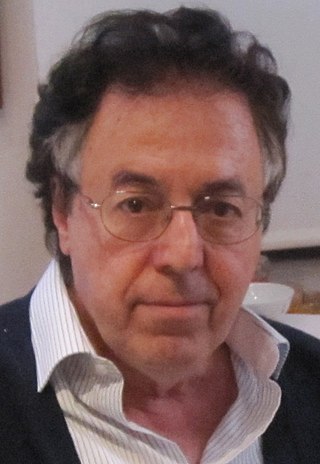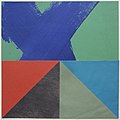Top Qs
Timeline
Chat
Perspective
Guillem Ramos-Poquí
Spanish painter (born 1944) From Wikipedia, the free encyclopedia
Remove ads
Guillem Ramos-Poquí (born 1944, Barcelona) is a painter who was a major figure of Arte Povera and Conceptual art in Catalonia during the 1960s. He has lived in London since 1968.
Remove ads
Studies and early career
Guillem Ramos-Poquí grew up in Barcelona where he studied painting at the city's School of Fine Art. During the 60s he was a major figure in the Catalan Conceptual art and Arte Povera avant-garde. After being awarded several art fellowships that took him to Paris and New York, he settled in London in 1968 where he studied at the Slade and the Royal College of Art. In 1995 he received his Ph.D. in Fine Art Painting from the University of Barcelona for his art work and thesis entitled The Conceptual Dimension in Art: Theory as an Inherent Component of the Practice of Painting, written in Catalan. He was Head of Fine Art at Kensington and Chelsea College (1990–2004)[1] and Lecturer in Advanced Painting at Morley College (2004–2012).[2] He has exhibited extensively in London and abroad.
Remove ads
Post-Pop Art and Minimalism
In 1965 Ramos-Poquí was awarded a fellowship from the French Government to work in Paris and was given a studio at the Cité internationale des arts in Paris[3] where he held an exhibition of collages featuring photo cut-outs, graffiti and letter/number transfers. Although these 1965 collages have a post-Pop Art feel, their employment of a personal code and incorporation of mechanical, automatic and lyrical formal elements defy categorisation. His 1967 work, exhibited in the Gallery of the Institute of North American Studies in Barcelona, consisted of a series of minimalist 'signs' made with industrial spray paint. Ramos-Poquí was granted the American Elias Ahuja Art Specialist Fellowship to New York, where he had a studio from 1967 to 1968.[3]
- 'Collage of the Telephone' on paper 1965
- 'Eyes' Collage on paper 1965
- 'Eight Signs'. 1967. Industrial spray on paper and canvas
Remove ads
Arte Povera and Conceptual Art
Summarize
Perspective
Ramos-Poquí belongs to the generation of Catalan artists of the 1960s who emigrated to Paris, London and New York, including fellow artists such as es:Antoni Llena, who also spent time in London, Antoni Miralda, Benet Rossell and Jaume Xifra. Ramos-Poquí’s works from this decade include a series of collages juxtaposing dynamic forms with the use of industrial spray paint to allude to mechanical progress. During the 60s he also produced a series of ‘found objects’ belonging to the consumer market, with which he created assemblages. They reveal the impact of Pop Art and the works of Rauschenberg on his work. The small scale and poetic associations of many of these assemblages from the 60s echo the Surrealist objects by Joan Miró and the boxes by Joseph Cornell, as pointed out by the author Gerald L. Bruns[4] and the art critic ca:Pilar Parcerisas i Colomer.[5] Other assemblages are more explicitly linked to a spirit of revolt. In September 1968 he staged an exhibition and installation of his Arte Povera 'found objects' displayed in boxes and Conceptual Art pieces, consisting of 'photographs of ideas', at the Arts Lab in Drury Lane, London. Because of these works he is considered, according to Catalan Art Critic and Historian ca:Alexandre Cirici i Pellicer, the forerunner of Arte Povera and Conceptual Art in Catalonia.[6]
- Beggar's Box,1968
- Boxes and assemblages, 1968
- Photographs of ideas. Left: 'Girl in a Garden', 1968. Right: 'Aeroplane in a Garden' 1968
Geometric colour field paintings
Summarize
Perspective
His colour field paintings show the influence of Rothko and North-American Post-painterly abstraction, especially Barnett Newman, Kenneth Noland and Frank Stella.[7] He reached a post-Bauhaus geometric synthesis rooted in theories concerning visual perception, demonstrating an indebtedness to the geometry and colour of Johannes Itten, Rudolf Arnheim, and Josef Albers. In Paris he became acquainted with a Bauhaus pupil of Paul Klee, Mordecai Ardon, while in Chicago he met György Kepes who, together with Moholy-Nagy, founded the New Bauhaus (today the IIT Institute of Design in Illinois). Further encounters with Ola Okuniewska (Ola Wolpe) and Clement Greenberg also impacted his work. His passion for geometry continued throughout his career, right up until the present day. During the mid-70s he started teaching in London. His extensive knowledge of the techniques of painting led to him giving a series of demonstrations at the National Gallery and at several art colleges. In London he founded the Essendine Art Centre, where he taught advanced printmaking, life drawing and techniques of painting to young art college graduates. One of the specialized courses focused on 'The Technique of Icon Painting.'[8] The success of the course led to the commission of a book on this subject, published by Search Press Ltd. It has been translated into seven languages.[9]
- Painting, 'Geometric Interruption' oil on paper 1970
- Painting, 'Leaves 2', oil on canvas 1 1/2m x 1 1/2 m, 1970
Remove ads
Paintings, Digital Art and Assemblage (art)
Ramos-Poquí refers to his intimate works of the 1980s as ‘symbolic paintings' which were followed during the 90s by a series driven by urban inspiration known as ‘Satirical and Metaphysical Urban paintings’, executed while he was developing digital photomontages.[10] Having already produced lithographs and etchings, it was during this period that he explored the possibilities of this new digital medium.[11] His digital photomontages were exhibited in London. They were praised by art critics including es: José Corredor-Matheos and reviewed in many London papers.[12][13] In 2001 he was commissioned to design the book covers for the Open University course 'Exploring Psychology.'[14] His assemblages, of a satirical nature, were exhibited both in London and Belfast.



 |
 |
Remove ads
Painting-collages
- 'Proposition a' 2013. Painting on canvas
- 'The Confines of Freedom' 2013. Painting on canvas'.
His 2014 painting-collages were exhibited at the Royal Artistic Circle of Barcelona alongside some examples of his works from the 60s which he had exhibited in Paris in 1965 at the Cité internationale des arts.[15] The art critic ca:Pilar Parcerisas i Colomer reviewed the show for El Temps and noted the works' unique approach to technique which incorporated egg tempera, sand, acrylic and objects from a mirror shard to a clock face. She also pointed out his references to works by the Old Masters, including Dürer's Melancholia.[5]
Remove ads
Mixed-media collages
Summarize
Perspective
- 'Cloud' 2014, mixed-media collage on white card
- 'Symposium' 2014, mixed-media collage on Japanese paper.
In his recent 2014 mixed-media collages 'found objects', text and fragments of reproductions by the old masters interact with the other elements of the composition. Found objects include dried flowers and leaves, insects, feathers, bottle tops and mirrors, broken clocks, pieces of embroidery, threaded paper, fragments of text or musical scores, and crystals. All of these elements possess intrinsic metaphorical values and, in terms of contrasts of textures, colours and formal transformations, relate to the artist's work as a painter as well as his early collages and assemblages. They affirm that the old masters remain an inspiration to contemporary artists today in their endeavour to interpret the world. A catalogue of these collages includes an introduction by Professor David Jasper, an expert in the field of Hermeneutics (University of Glasgow). He describes his mixed-media collages thus:
In the complex and riddling collages of Guillem Ramos-Poquí we might glimpse a recovery of the art of memory as it is rooted in the sense of sight, and in its further verbalisations, a haunting presence of the divine in the midst of the contradictions and strange encounters in the world around us.[16]
Remove ads
Selected exhibitions
1965–1970 (Collage, Mixed media, Arte Povera, Conceptual Art and Installations
- 1965: Paris: Cité internationale des arts, Paris (one-man show)
- 1965: Barcelona: Lleonart Gallery, Barcelona (one-man show)
- 1966: Paris: Galerie des Beaux Arts
- 1967: Barcelona: Institute of North American Studies, Barcelona
- 1967: Ibiza (Spain) Ivan Spencer Gallery
- 1967: New York: One Eleven Gallery
- 1968: New York: The Art of the East Village
- 1968: London: The Arts Lab, Drury Lane (one-man show)
- 1968: Cuenca: (Spain) Casa de la Cultura (Museum of Spanish Abstract Art)
- 1970: Essex: (England) Wansfell College Gardens, Epping, (one-man show)
1971–1973: Geometric abstraction: Color Field paintings
- 1971: Barcelona: Aquitania Gallery, Barcelona (one-man show)
- 1971: London: Spanish Institute (one-man)
- 1972: Barcelona & Madrid: Institute of North American Studies (one-man show)
- 1973: London: Institute of Contemporary Art (I.C.A.)
1981–1996: Paintings
- 1981: London: Camden Arts Centre
- 1982: Paris: Grand Palais
- 1982: Paris: Galerie des Beaux Arts
- 1984: London: Chenil Gallery (two one-man shows)
- 1985: London: Royal Horticultural Halls
- 1987: London: Blenheim Gallery (one-man show)
- 1987: Oxford: Oxford Central Library
- 1989: London: Englands & Co. Art Gallery
- 1989: London: Milne Moller Gallery. 1989: London: Tabernacle Gallery (Tabernacle, Notting Hill)
- 1991: London: Sweetwaters Art Gallery (one-man show)
- 1992: London: Tricycle Art Gallery (one-man show)
- 1994: London: Queen Elizabeth Hall, South Bank
- 1994: Barcelona: Salón del Tinell. 1996: London: The Mall Galleries (Federation of British Artists
- 1996: London: Eurofair'96, Royal Horticultural Halls (one-man show)
1997–2004: Digital Art (Photomontages), Assemblages
- 1997: Brighton: University of Brighton Art Gallery
- 1997, 1998, 1999, 2000, 2001, 2002: London: Colville Place Gallery
- 1999: Barcelona: Caligrama Art Gallery (April – May)
- 2003, 2004: London: Deluxe Gallery, 2-4 Hoxton Square, London
- 2004: Belfast: Catalyst Arts Gallery Set-Oct (one-man show) Northern Ireland
2007–2014: Painting, Painting-collages, Mixed-media Collages
- 2007, 2008: London: Bernard Chauchet Gallery, London SW10. (June and December collectives).
- 2008: London: Royal Academy Summer Exhibition
- 2008: Santander: Sala Nao
- 2008: London: Royal Overseas League Club (Open Door Exhibition) Piccadilly
- 2010: London: Morley Gallery
- 2011: Barcelona: Casa Elizalde Centro Cultural
- 2013: London: Tabernacle Gallery
- 2014: Barcelona: Reial Cercle Artistic de Barcelona
Remove ads
References
External links
Catalan bibliography
Bibliography: Digital photomontages
Wikiwand - on
Seamless Wikipedia browsing. On steroids.
Remove ads











